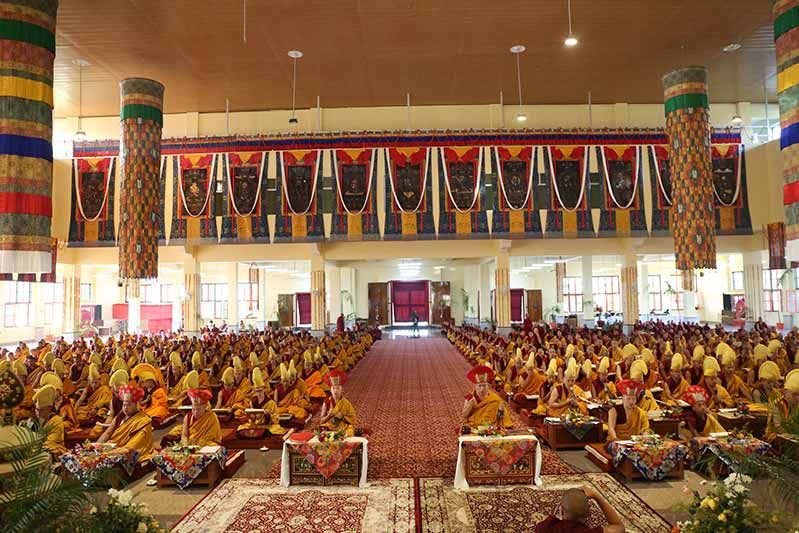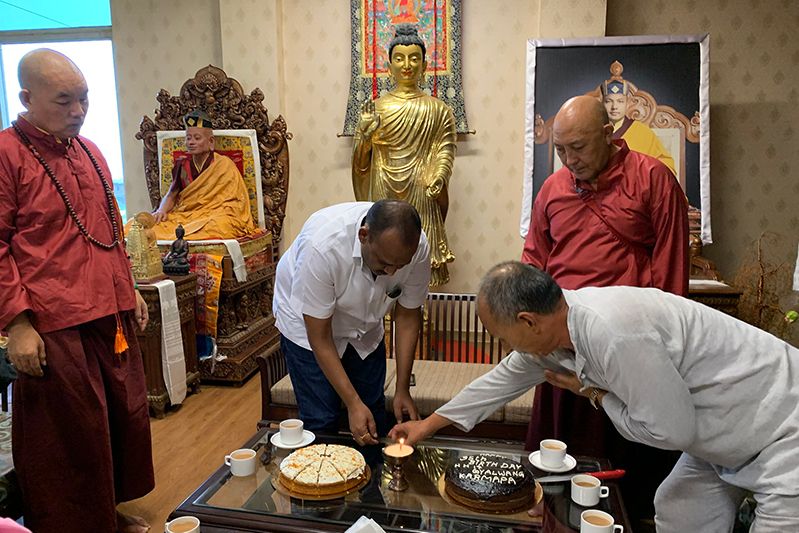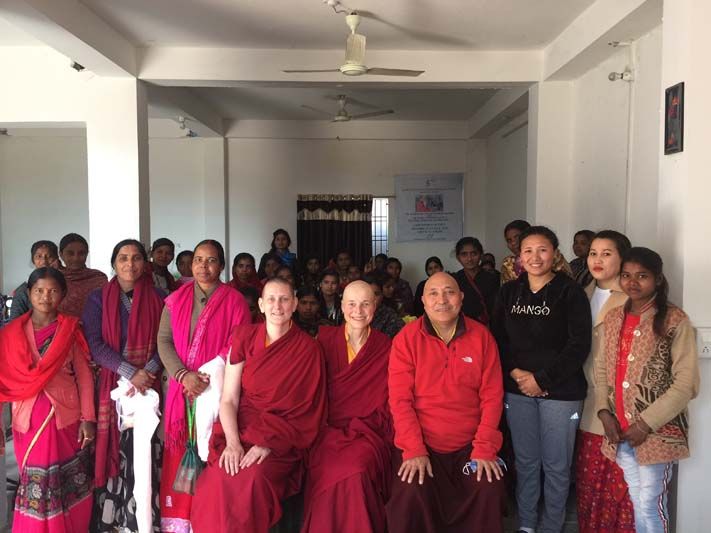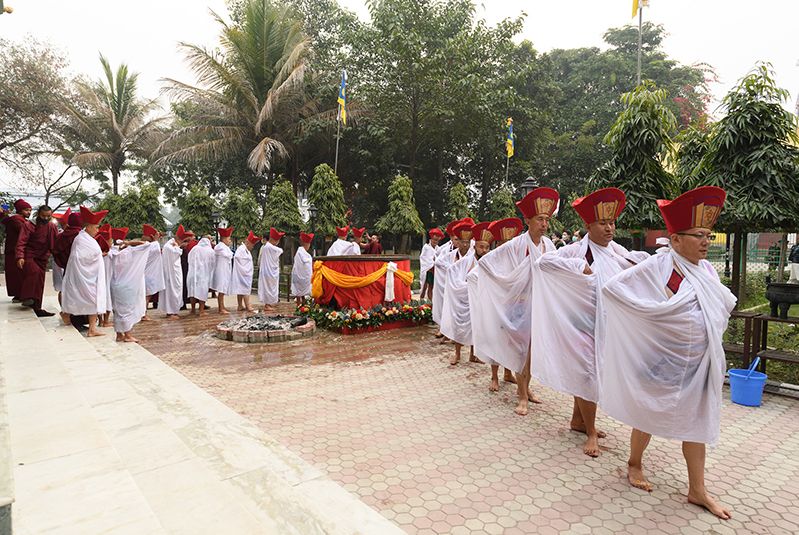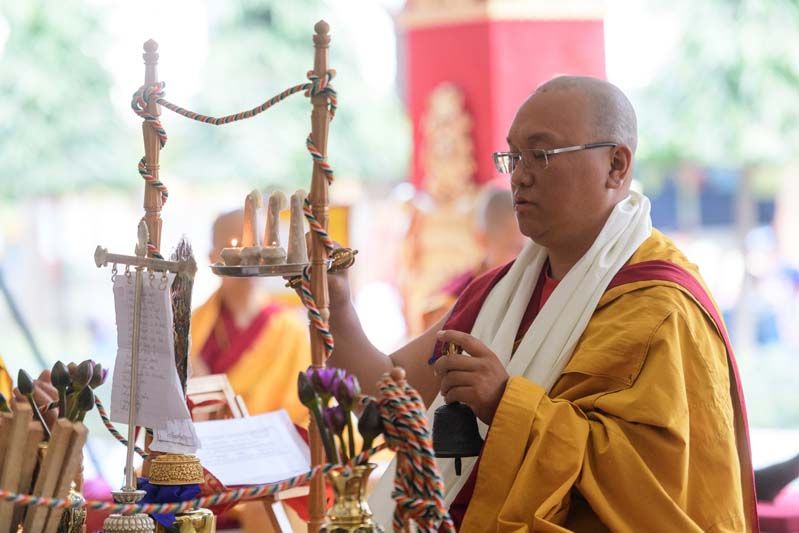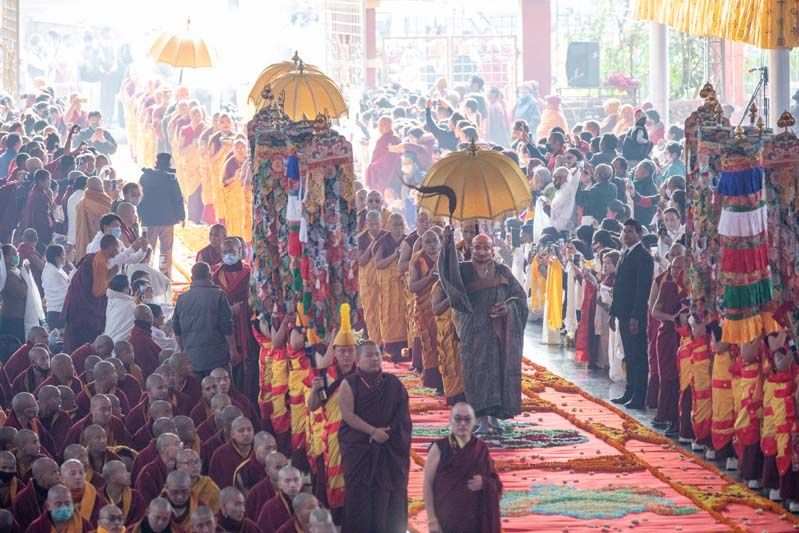Nitin Sawhney Plays for the Karmapa: An Interview
- March 2, 2017
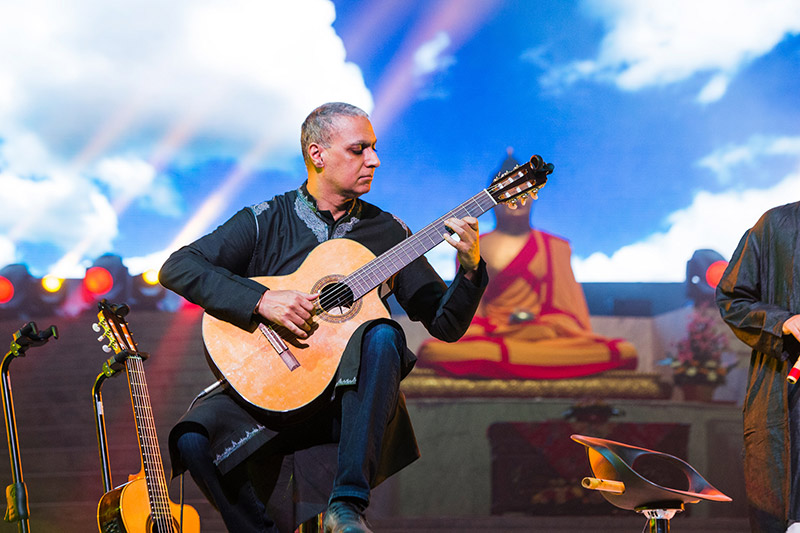
Monlam Pavilion, Bodh Gaya, Bihar, India
The famous musician and composer Nitin Sawhney was invited by the Gyalwang Karmapa to perform at this year’s Marme Monlam, the spectacular end to the 34th Kagyu Monlam. In a break between rehearsals, Nitin responded to questions about his spiritual path and his music, how he came to be at the Marme Monlam, and his thoughts about the Karmapa.
Kagyu Monlam Reporter: I’d like to ask you first about your childhood. There’s a spiritual current in your work and I wonder if you can trace that back to your family and its influence.
Nitin Sawhney: My mum comes from a very strong, ancient Hindu background and had an interest in ancient Hindu philosophy. She’s a Brahmin and used to recite prayers with us every Tuesday. She taught me a lot about the Vedas, even mathematics and also yoga. She would talk to us about ideas from the Vedas, the Upanishads, and the Bhagavad Gita. I’m always interested in that heritage, which was quite strong in my family.
KMR: Does it influence what you’re writing now?
NS: Yes, very much. What’s interesting is that the second piece we’re playing tonight is a piece I wrote called River Pulse, which is the only piece I’ve ever written that has to do with anything Buddhist. When I wrote it, I had the image in my mind of the Buddha sitting under the Bodhi Tree and the idea that the pulse of the river gave him enlightenment. Of all the songs proposed to him, the Karmapa asked me to play this piece, and he had no way of knowing that I wrote it purely about the Buddha’s enlightenment. The fact that he chose it is the main thing that made me want to come here, as I thought, “Well then, it’s supposed to happen.”
Actually, there are a lot of stories around this. Just before I came Bodh Gaya, I was staying at a yoga retreat that gave me time to prepare myself mentally and spiritually for being here. There was ayurvedic and yogic practice as well as different exposures to Indian classical music. I even read a book about Buddha while I was there.
In terms of my childhood, I think my mum and dad gave me their perspective on what Hinduism meant to them. In some ways I think religion has been difficult for me because sometimes it can get in the way of spirituality, so the two can be in conflict. But the way my mum and dad taught me about Hinduism, there was no conflict. I felt very much at peace with the idea of spirituality and the essence of it.
KMR: Is that because their approach was more experiential?
NS: Yeah, I think so. And also music has been a very, very good way for me to find a lot of truth. I think music is the voice of the universe. In my perspective, OM was the first word that was uttered. That’s very powerful, as I think it manifests itself when we’re playing “River Pulse” or even “Sunset.” There’s the concept of playing in a key, which is actually the implied OM that is around us all the time. We’re playing from that beginning always. It resembles an idea from Pandit Ravi Shankar who said, “You’re a vessel to be filled with the feeling and the sound of the universe.” It comes through you and you’re just a medium for it to manifest. I really liked this idea.
I’m also interested in the idea of being in tune with yourself. As a musician, you have to tune your guitar, and when you play with other people, you have to tune to them. I think it’s the same when you come to a new country or place. You might be in tune with yourself, but you have to tune again to the place you’re in and to the people around you. I don’t really go with the morality kind of concept of right and wrong or good and evil—this is too much of a dichotomy. I’m much more into the idea that we flow with discord or not. If we are discordant with what is around us, then it feels wrong, it doesn’t work. But if you are in tune with yourself and what’s around you, then everything flows very smoothly.
KMR: In Buddhism, there are the concepts of the ultimate and the relative, which are inseparable. You can move from the relative into the ultimate, and through the dynamic compassion, the ultimate becomes embodied as the relative.
NS: You’re right. It’s the dynamic of compassion. And to be compassionate, you have to be in tune with yourself first. Compassion cannot come from someone who is not at ease with themself, who is insecure, worried, or anxious.
It’s like music. If you’re playing music and the notes are not in tune, you just automatically stop playing because it doesn’t feel like it’s working. It’s the same thing with the way we are – I guess.
KMR: Sound is also interesting for its ontological status. It’s not a solid thing like this table and yet it’s not nothing either. It occupies a space somewhere in between.
NS: It’s interesting that you should say that. There’s a mathematician named G. H. Hardy who once said that the only true reality was mathematics, because it’s something that never changes. Like you said, the table appears to be solid, but actually 100,000th of diameter of each atom is the nucleus and that’s where most of the matter is, so actually everything we see around us is mainly emptiness.
Music is like this too. Einstein said that relativity came to him through musical intuition, so it’s actually his realization of what the universe was. This understanding of the universe came to him through musical feeling, so I think music is a very powerful voice of the universe.
KMR: And it’s used in all spiritual traditions. They all chant and sing. There’s also something about the vibrations of our own voice or a musical instrument lightening the solid sense our body, so it’s easier to tune into what’s called the body of light.
NS: I agree. I think that’s very true. When you play music there’s a transformation of your normal self into more of an extension of the universe, rather than just being an isolated being. That’s why I love playing with other musicians, because you’re communing together with the voice of the universe.
KMR: Is there a sense also of flowing out to the audience?
NS: Very much. I think there’s electricity that happens between the musicians and between the musicians and the audience. There’s a feeling that spreads. If you have a good spirit between you on stage and it’s working, then it’s effortless for that to spread. You don’t have to try to make it spread; you just feel it and everyone can feel the same. It’s an infectious feeling rather than a performance feeling.
KMR: One of your albums is titled OneZero, which is very Zen, and your aesthetic is also minimalist. That’s quite different from the profusion of Hinduism.
NS: There are different interpretations. Hinduism was originally an oral tradition. The ornamentation of how temples look or the aesthetic of how Hinduism looks these days is like the catholic church. It’s like Martin Luther when he broke away from the catholic church. He said he was justified by faith alone. He turned around and in 1517 he nailed up the Ninety-Five Theses on papal indulgences at the church in Wittenberg. In a way, the beginning of Protestantism was a breaking away from all that kind of ornamentation and opulence that the catholic church demonstrated.
I feel that as well about anything that is too demonstrative of opulence. I naturally shy away from it. I’m much more interested in a pure form of expression that comes from a feeling which is effortless. You don’t need to have lots of ornamentation or attempts to beautify anything. What is graceful is automatically beautiful. In the music you play or whatever you do in life, there should be a sense of grace to the way it works, and then there’s no effort involved.
KMR: In Buddhism, there’s the idea of approaches being elaborate or unelaborate. Emptiness is described as unelaborate, so it doesn’t have a lot of conceptual proliferation around it. It’s just very clear and simply is what is.
NS: Yeah. Absolutely. That’s the thing, and I always like to start everything from emptiness as much as I can. I like to take time before I begin a track, or anything really, to just be in the moment without rushing, because the music should come from that moment and not from panic about what happens next. That’s the danger. When music doesn’t work for me is when you can hear the panic. For me music should always come from somewhere that sounds gradual and gentle. Even if it comes with a lot of energy, the energy comes from somewhere graceful.
KMR: Do you meditate?
NS: I meditate a lot through music and I also take time to do yoga every day. During that I normally do some breathing techniques and just before I start the yoga session, I’ll have ten to fifteen minutes of silence and meditation.
KMR: Patanjali Sutra has wonderful teachings on the mind, which are similar to Buddhism.
NS: Interestingly Patanjali talked a lot about ideas that were actually impossible in modern thinking, like the idea of flying or levitating. I think that is symbolic of breaking free from or expectations of yourself or limitations you place on yourself psychologically. Everyone has insecurity about their capabilities or their context or how they relate to other people. It’s important to find your own sense of value with yourself.
Insecurity breeds fear, and fear breeds a need for power. I see this in so many places. I think this is what is going on in the world right now with certain people. It’s scary because you can see how much insecurity there is in one person and the fear that comes from it. There’s paranoia and then the need to impose power on people. This cycle creates so much hate. So I think it’s important to be at peace with yourself before you begin anything.
KMR: There’s a line in the Heart Sutra that has always fascinated me. It says that since the bodhisattvas have no afflictions—no ignorance, hatred, attachment, pride, jealousy, etc.—they have no fear. So if your mind can touch into that inner purity or emptiness, there is no fear.
NS: Buddha found enlightenment by escaping suffering and pain. He transcended the cycle of suffering and pain that we’re all in.
KMR: And that suffering comes from these negative afflictions.
NS: Yes. And I think this is one of the beautiful things about music. When you are playing music and you’re in the right space, there’s the sense that, even if it’s for a short time, you can transcend all those feelings of fear, worry and anxiety and be genuinely in tune with something much bigger, much larger. It’s those moments that are very valuable.
There’s one piece I play called Prophesy, which we are not performing today. I wrote it originally as a homage to the land that I am in. It’s about listening to the drone of the insects and the sounds around you. You gradually evolve a piece of music that speeds up in the Sufi way, like how the whirling dervishes do. They spin faster and faster and it’s the same concept with the music. There’s something about celebrating the universal power. Sometimes when you’re playing, it’s like the charging of a battery. You feel that you’re becoming more and more charged by a universal spirit that flows through you. It’s really an amazing thing.
KMR: In whirling there’s a point when the turning takes over and you’re no longer there.
NS: That’s the same with Prophesy because it’s actually a piece that speeds up in the same way. You can watch your hands and everything is working together. I’m aware of Aref on the tablas, and when we’re playing together, we’re very much as one because we’re both communing with the same thing. It’s a nice feeling.
KMR: There’s something similar in mantra practice. A seed syllable is visualized in your heart and the mantra turns around it. When you’re first working with it, you have to get used to it, think about the shapes, the colors, and the movement. Then slowly, the mantra starts speeding up and turning on its own.
NS: Exactly. It’s very powerful.
KMR: Do you think that when things go well, this gets communicated to others?
NS: I think so. As I said, when you have the right feeling between you, then that automatically, not necessarily gets communicated, but it effects the room in a good way like a benign virus. It’s more than communication, which is so linear. An infection is something that spreads, and the feeling that comes with music is like that, something that spreads around you, so it can be between people, between the air. It’s a feeling, an electricity, that’s created in a space.
KMR: You’ve also been involved in music education. Is it part of your compassionate involvement in the world?
NS: I like to do lots of work with kids, university students, and local communities. I think it’s important. With me it can be a bit selfish, too, because I learn a lot from teaching and working with younger people. You can remember what it is to learn and feel excited about something when it’s experienced for the first time. I have been showing Kara the singer how to do Vedic mathematics and mental arithmetic, for example, the 100 times table in her head. She had not done that before, and she’s been practicing and got very excited, asking me to test her. It’s nice. You think, “Oh wow. That’s what I used to feel like when I first was learning.”
It reminds you, so you don’t become complacent and take things for granted. I think it’s one of the most important things. We’re all very privileged to play music, and to play for the Karmapa in this space is a great privilege. The moment we forget that is the moment we lose ourselves.
KMR: Have you played for a spiritual teacher before?
NS: No, but one great thing that happened to me was interviewing Nelson Mandela. I think he was an amazing human being. I can’t, however, think of any spiritual teacher off the top of my head.
KMR: This is the first time then.
NS: Yes, I think it probably is. It feels very natural to be here and very good. I like how relaxed the Karmapa is. How he walks around with humility and with the sense of being with people. He’s not arrogant or anything like that, which is a great thing, because he could be but he’s not, which is great to see.
KMR: He was once asked what his mission was, and he replied, “To bring Buddhism into the 21st century.”
NS: Yes, I can see that. I get that totally. There’s a quotation from Zen and the Art of Motorcycle Maintenance, in that book it says “Buddhism is not to be found only in the petals of a flower but also in the console of the computer.” It’s a great quote. It’s not the idea of pantheism, it’s more that spirituality is within and everything else is an illusion. The idea that one thing is more spiritual than the other is crazy. Bringing Buddhism into the 21st century makes a lot of sense to me. People get buried in tradition and sometimes they can think that’s where spirituality is. But actually it’s not. It’s in our everyday life, how we speak to each other, how we respect each other, how we look at the universe, how we show compassion, how we think and feel. In that respect I think the Karmapa is saying something very wise.
KMR: One of the definitions of buddhahood or enlightenment is that there is absolutely no difference between meditating on a cushion and being out in the world. The two are equal. When they were planning a new building at the Karmapa’s seat in New York, he was asked where he wished to have his rooms. One option was on the quiet side of the structure with a beautiful, long vista of the mountains and a lake in the distance, and the other overlooked the parking lot. He chose the later so he could see people.
NS: Makes a lot of sense.
KMR: You had mentioned a history of coincidences that brought you here. Could you tell about them?
NS: When I was sixteen I wrote this piece about the Buddha under the Bodhi Tree. What happened was, I went to see a play of Garcia Lorca, called Yerma and there was a Punjabi translation of it, which I thought was fantastic. I felt the performance to be very strong. Afterward I went back to see the director afterwards who was a woman, called Neelam Mansingh Chowdhry and I said to her, “If you ever want me to do anything for your theater company whether it’s playing music, writing it, or even sweeping floors, I don’t care what it is, I’ll do it.” I asked her, “Where do you work?”
“We work in India,” she replied.
I said, “Maybe one day I can come there.”
“You’d be very welcome.”
Three months later, I decided that I was going to try and find her, but this was back in the early 90s, and I had no way of tracking her down. So I went to India and was staying at my uncle’s house in Gurgaon near Delhi. I said to him, “ Do you know this person? Her name is Neelam Mansingh Chowdhry and she’s a great director.” He replied, “ I have no idea how to find her, but your uncle in Chandigarh might know. I’m going there at 6 o’clock tomorrow morning. Would you like to join me?” I said, “Sure.” So we were standing on the train platform and I remember looking up and seeing a monkey silhouetted against the morning sun, and then a voice next to me said “Nitin.” I turned around and it was Neelam Mansingh Chowdhry. “How are you?” she asked. I’m all right and surprised you remembered me.”
She said, “Yes, I remember. We had a nice conversation.”
“Well,” I said, “I came here to find you.”
She didn’t seem that surprised and said, “Well, we’re going to Chandigarh now. I live there. Is that where you’re going?”
I replied, “Yes, with my uncle.” “Why don’t you join us?”
So for the next two weeks, I spent time with her at her amphitheater, and then lost track of her. Fifteen years later, I was speaking with the Indian film director called Deepa Mehta, who was talking to me about writing music for Salman Rushdie’s Midnight’s Children and I said I’d love to do it. At the end of our two-hour long conversation, she said, “There’s one other thing. I really want to introduce you to somebody I know you’ll get along with.” Without her saying anything else, and even to this day, I don’t know why I said this, “Is it Neelam Mansingh Chowdhry?” “Yes, she’s my best friend. How did you know?” “I don’t know,” I replied. Then we talked for a bit.
Now I was telling this same story to a person named Veer Singh, who had invited me to stay at the yoga retreat I spoke about before. He said, “That’s amazing. She’s my aunty. That place you were talking about with the amphitheater its half owned by my grandmother.” Veer had also had the Dalai Lama stay at the retreat and in my room there was one of his books on Buddhism I read whilst I was there. I told Veer I was coming to Bodh Gaya and he knew a lot about the Karmapa and Buddhism.
It was interesting as I had a great experience coming here. It was very purifying, even literally with detoxing. It’s strange because it feels like a very interesting path that has led me here that started a long time ago. I have had many, many coincidences in music that are crazy but this feels related to me being here in Bodh Gaya with the Karmapa today and interesting that he chose my track River Pulse to play as he wouldn’t know it was related to Buddha sitting under the Bodhi tree.
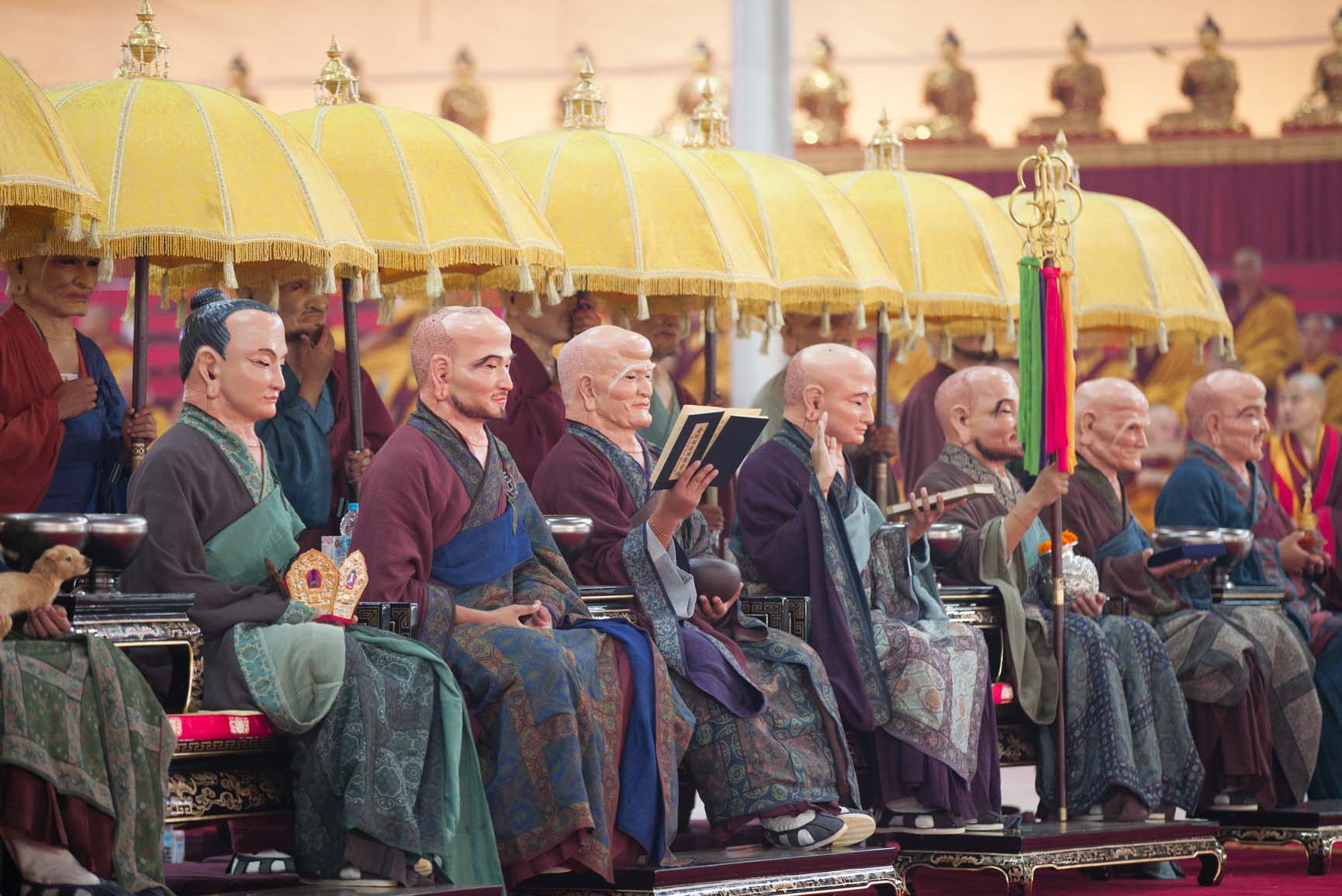
37th Kagyu Monlam Schedule
Tibetan / English / Chinese • French • German • Indonesian • Korean • Polish • Russian • Spanish • Vietnamese
Dharma Teachings
 Meditation Instructions
Meditation Instructions
Recorded during the 37th Kagyu Monlam, Bodhgaya, India. January 28-30, 2020.
